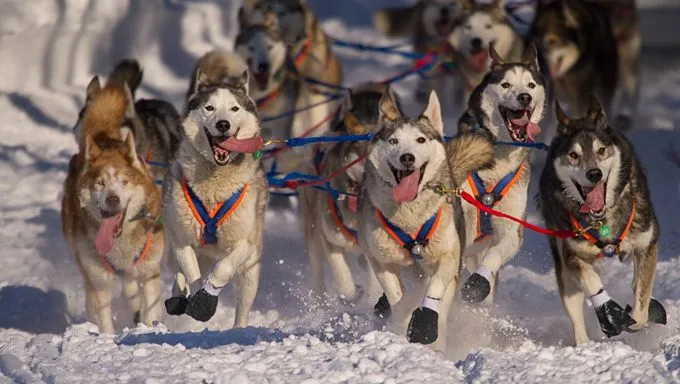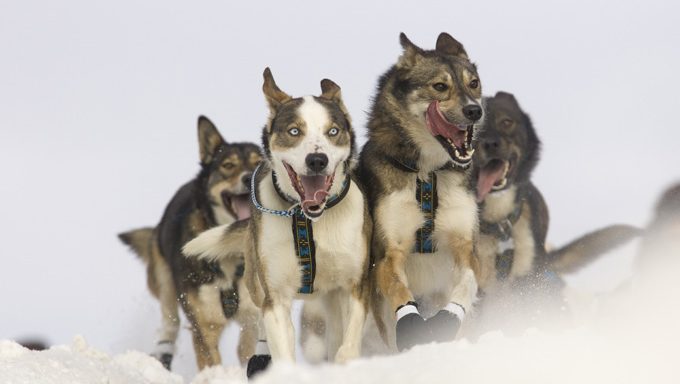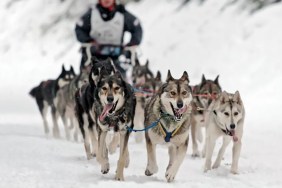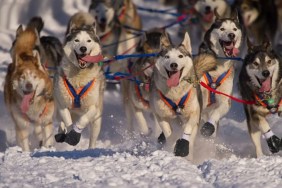
In 2022, the Iditarod, Alaska’s most famous sled dog race, begins on March 5th outside Anchorage. Each year, the event stirs up controversy among those most passionate about humans’ best friends: the dogs.
Opponents of the Iditarod contend the race is nothing less than abuse, that the dogs are driven to exhaustion, forced to perform in the face of severe frostbite, broken bones, pneumonia, and dehydration.
Supporters of the Iditarod argue these dogs are among the happiest and most cared for animals in the world, basking in the opportunity to do what they were born to do. The race also commemorates the Great Race of Mercy when Balto, Togo, and other sled dogs raced to bring medicine to Nome during a diphtheria outbreak in 1925.
Who is right? Is the Iditarod race a form of animal cruelty? Or is it an event that celebrates dogs?
The Controversy Of The Iditarod
I don’t pretend to have the answers. Any time we humans solicit an animal to perform for our benefit, we can only guess as to the animal’s level of enjoyment or stress.
From agility competitions to kennel club shows to rodeos to the running of the bulls, each event can be plotted at a point on a spectrum of how damaging or enjoyable it can be for the animals involved. Where the Iditarod falls is up for interpretation.
Discovery Network reporter Kasey-Dee Gardner interviewed both supporters and opponents of the race in hopes of categorically determining whether the Iditarod is a mostly positive or negative experience for the dogs who run it.
Gardner first spoke with kennel manager Karen Fortier, who asserted: “[The dogs] get tired at the end of the day, running a hundred or more miles a day, but they’re not pushed in any way to do it.” She added, “It’s their own will.”
Gardner also talked with musher Kate Palfrey. Like many Iditarod aficionados, Palfrey refers to her dogs as athletes. She defended their lean body mass this way: “Things I always hear: They’re too skinny. Well, have you ever seen a marathon runner that has an ounce of fat?”
Palfrey has a point, but is it the relevant one? Of course, marathon runners maintain a particularly spare weight to ensure the greatest advantage in competition.
The difference is that the dogs aren’t given an option. They adhere to their musher’s exercise regimen, they re-hydrate when their musher decides it’s time, and they rest only as long as their musher permits.
Bred For It, But Does That Make It Okay?

Proponents say the sled dogs are bred not just to run, but to race. Whether breeders can select for a particular distance or a certain set of conditions, I don’t know. Is it safe to assume their genetic makeup means they relish running 15 miles a day? Or 20 miles a day? Marathons?
Does being “bred for the sport” mean the dogs are born with the capacity and desire to run ten back-to-back marathons? Or 20 back-to-back marathons? Or 30 back-to-back marathons in biting wind, sub-zero temperatures, over grueling terrain with only four hours of rest?
I don’t know the answer. I only know the Iditarod is about the equivalent of 38 back-to-back marathons: almost 1,000 miles in ten days.
Maybe it is a fair assumption that, because these dogs were bred for it, they indeed would choose to exert themselves to the point of exhaustion. They may well live to run. But to race?
Just as with horses or Greyhounds or pigeons, the races are really for humans’ benefit, as are glory, fame, and prize money. I’ve never seen a dog express an interest in winning — only in doing what they enjoy.
My guess is that a dog would not run 100 miles a day for ten days straight just because they feel like it. I’ve never heard of a dog doing so out of pure enjoyment, but admittedly, I don’t know.
There’s No Denying That The Race Is Dangerous

The Discovery Network’s Gardner reports, though, that no matter what your views are on the race, the dogs face “undeniably harsh physical and mental conditions as well as an extreme environment on the trail.” Even the Iditarod’s official site concurs:
[Mother Nature] throws jagged mountain ranges, frozen river, dense forest, desolate tundra and miles of windswept coast at the mushers and their dog teams. Add to that temperatures far below zero, winds that can cause a complete loss of visibility, the hazards of overflow, long hours of darkness and treacherous climbs and side hills, and you have the Iditarod…
Jan Bullock, the Iditarod’s former head vet technician acknowledges, “Most of the injuries I see are from running… They’ll get some swelling in their wrists, and it’s painful.”
And according to a study published in the Journal of Veterinary Internal Medicine, 61 percent of dogs who finish the Iditarod suffer gastric ulcers, which the researchers believe are caused by “sustained strenuous exercise.”
Still, many claim that the dogs would tell you the risks are worth it.
When Does A Sport — Or Anything Else — Cross The Line To Cruelty
Even more interesting to me than the statements from Iditarod supporters is the psychology behind how people justify their participation in activities that may be harmful.
For example: Rob Rogers purports to love, admire, and take excellent care of his strong, athletic dogs. He says they were bred for this life. They not only enjoy it; they choose to do it. Rogers, however, is not an Iditarod competitor and is not referring to sled dog racing. He’s a convicted — and proud — dog fighter talking about his Pit Bulls.
Make no mistake: I’m not comparing the Iditarod to dog fighting. But I am drawing parallels to the arguments humans make to justify a favorite pastime or gainful vocation in spite of the harm they might do.
Even compassionate, decent human beings fail to live a wholly benevolent life. The best, smartest, and kindest of us are flawed. We tend to do what we believe is good and accept — or even sometimes deny — that there might be some bad that comes along with it.
How did Thomas Jefferson justify owning slaves? How does the average American justify eating veal? Or cheese? Or eggs? Is it worth finding out what life is like for the typical dairy cow, or is it acceptable not to be concerned?
Okay, so what does eating veal have to do with the Iditarod? Perhaps not much. But if animal welfare is mapped on a spectrum, at some point a line is crossed.
Where is that line? How much gray area is there? When does compassion end and cruelty begin? And is that for humans to decide, simply because we can?
I enrolled with my dog in an agility class. I loved it. But did he? Where is agility training on the spectrum? Where’s the Iditarod? Where’s dog fighting?
We humans use animals to assist with hobbies, keep up with fashion trends, earn paychecks, and fill our plates. We owe it to them to keep asking questions and to take into account their potential suffering.
You may not agree with my conclusions, but the conversation must continue.
With this in mind, where do you stand on the Iditarod race? Is it fun for the dogs, or is it cruel? Or is it somewhere in the middle? Let us know in the comments below!









